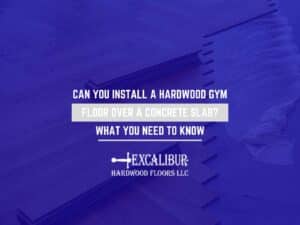Synthetic vs. Hardwood floors: What’s better For a Gym?
Comparing Durability, Maintenance & Performance For Gym Flooring
A solid gym floor is crucial for practicing different physical activities at any school or university. For choosing the correct floor, you should consider the cost and maintenance and what sports or activities will be practiced on it.
Some factors that you may consider when installing a floor in your institution are maintenance, hardness, and bounce, as well as its life span. Excalibur Hardwood Floors offers the best flooring solutions. We install, repair, and maintain your floors to keep them as new.

What Are The Main Differences Between Wood & Synthetic Gym Floors?
Each one of the options has its advantages and disadvantages. Here’s a list of them so you can check them and chose which one suits you best.
Maple Hardwood Floor
This floor is hard and durable, and, as its name shows, is made of maple wood. It is the best one for volleyball and basketball games and tournaments. They can be installed with different methods: fixed, floating, or fixed resilient.
- Fixed floors are stable, so the play is more quiet. The flooring layers include a vapor barrier and underlayment.
- Floating floors are resilient and offer a uniform base. Its system also has a vapor barrier, and also padding and subflooring.
- Fixed resilient: an anchored floor that offers cushioning and enhances play. It has anti-squeak anchors suitable for different sports and activities.
Synthetic Gym Floors
Synthetic floors are used for many sports and activities that take place at universities or schools. Some of the synthetic gym floors available are polyurethane, vinyl, vulcanized rubber, and hybrid (a mix of polyurethane and vulcanized rubber).
Some gyms choose these options as they are a more affordable option to hardwood floors as they have the similar permanence.
How Much Does a Wood Floor Cost?
Wood floors usually have a higher cost, but they are a long-term investment for your gym because of their longevity. If they are damaged, they can be partially replaced. This makes them a cheaper option in the long-term.
On the other hand, synthetic floors need to be maintained with certain regularity and replaced completely when damaged.
Maple hardwood floors include a subfloor installation and need some more steps than the synthetic floor installation needs, such as heat and impact layering, waterproofing the top layer, and markings across the surface.
Even if synthetic floors are cheaper and easier to maintain, they need to be cleaned more frequently than wood floors and are not suitable for all purposes.
Lifespan Of Hardwood vs. Synthetic Gym Floors: What To Expect
How long your sports floor will last will have to do with many factors such as daily use, maintenance, and general wear and tear. Wood floors are the better option when life span is considered. They can last 50 years or more if they are correctly cleaned and taken care of.
On the other hand, synthetic floors don’t last as long and they have to be replaced after 10 to 20 years.
Effective Maintenance Tips For Long-Lasting Gym Floors
Keeping your floor in good condition takes effort and time. To make sure the money you invested in it is safe, intensive maintenance should be done by floor specialists. As people move by or practice sports over it, the floor surface will deteriorate over time. Having a maintenance routine will help you keep your floor in good shape for long. Even if they don’t have the characteristics to resist all shoe types, wood floors resist huge impact volumes though impressions may appear.
A correct maintenance routine includes sanding once every 7 to 10 years. It is also recommended to recoat it every tear and the lines painted regularly. This should be done by a professional. Bear in mind that these types of floors shouldn’t be scrubbed with auto scrubbing as synthetic floors are.
Synthetic floors may need waxing and repainting during the year, as they start fading with use.
Impact On Bouncing & Athlete Performance
Hardness and bouncing on the floor are factors that affect athletes when playing or training. A harder floor helps athletes as they have to do less effort when running, thanks to the floor’s elasticity.
Especially for playing basketball, the ball should be able to bounce and rebound quickly, and this can be accomplished by installing a hardwood floor. Hardwood floors absorb less shock than synthetic floors which have a rubber base.
Because of the rubbery synthetic floors have, they are not the best option for practicing sports like basketball as they lack hardness and bounce to rebound balls. They are much better for PE activities, gymnastics, or sports that don’t need balls.
Transform Your Gym with Excalibur Hardwood Floors: Expert Hardwood Flooring Solutions
In case you decide on a hardwood floor, our trained gym floor specialists will ensure consistency in your project. Whether it is a home gym installation, basketball court or an institution’s gym, we at Excalibur Hardwood Floors have the best materials to to make a lasting floor. Contact us for a free consultation





